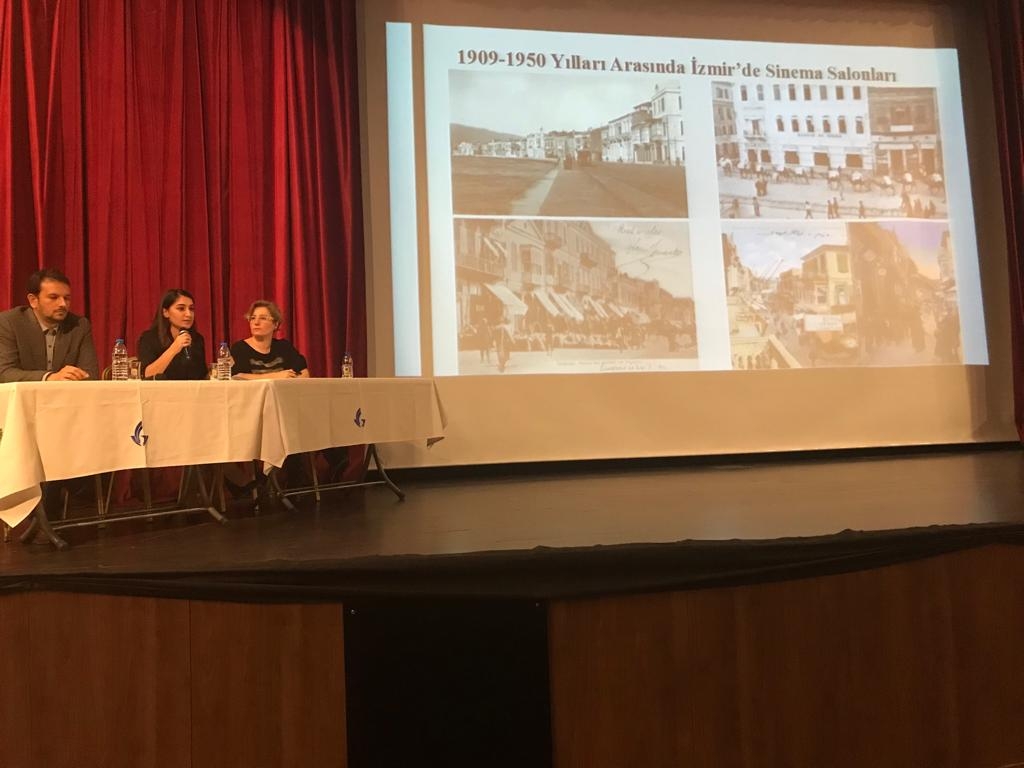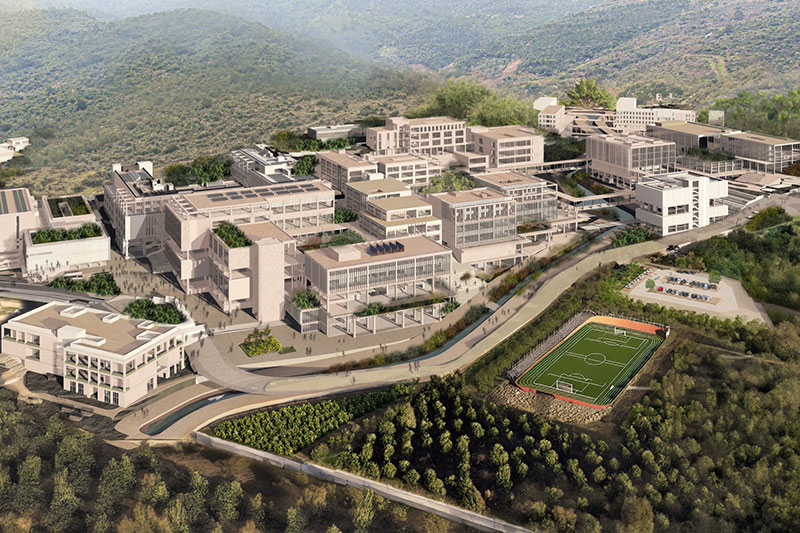
IZMIR CINEMAS WILL REVIVE
Film industry has been addressed at the “Revive Cinema in Izmir Again!” themed panel that took place on Thursday, December ...
| Course Name |
Introduction to Photography
|
|
Code
|
Semester
|
Theory
(hour/week) |
Application/Lab
(hour/week) |
Local Credits
|
ECTS
|
|
RTV 105
|
Fall/Spring
|
1
|
2
|
2
|
5
|
| Prerequisites |
None
|
|||||
| Course Language |
Turkish
|
|||||
| Course Type |
Service Course
|
|||||
| Course Level |
Short Cycle
|
|||||
| Mode of Delivery | - | |||||
| Teaching Methods and Techniques of the Course | Application: Experiment / Laboratory / WorkshopLecture / Presentation | |||||
| National Occupation Classification | - | |||||
| Course Coordinator | - | |||||
| Course Lecturer(s) | ||||||
| Assistant(s) | - | |||||
| Course Objectives | This course will consider theorotical and practical photography art issue. The aim of this course is; to discuss photography art aplications and methods. |
| Learning Outcomes |
The students who succeeded in this course;
|
| Course Description | In this course, starting from the history of the photograph, respectively, cameras, functioning and principles of operation will be examined, photography techniques, reading, photography, lighting, composition, framing and photo location in the communication process will be discussed. |
| Related Sustainable Development Goals |
|
|
Core Courses | |
| Major Area Courses | ||
| Supportive Courses | ||
| Media and Management Skills Courses | ||
| Transferable Skill Courses |
| Week | Subjects | Related Preparation |
| 1 | Introduction to the course | Meeting with students, information about the course content |
| 2 | Photography and photographic history-Camera Obscura-The invention of photography, Technical developments | Fotoğrafın Kısa Tarihi Yazar: Walter Benjamin Chapter:1 |
| 3 | Cameras, types, structure and elements -Photo light, color, and effects on photo | A'dan Z'ye Dijital Fotoğrafçılık Kitabı Yazar: Chris George Chapter 1.1 - Donanım ve Yazılım |
| 4 | The controls on the camera I, Exposure clutch components, -Diyafram-Enstantane-Iso - Measuring Light | Dijital Fotoğrafçılık Hakkında Her Şey Yazar: İsa Akalın Chapter 2 - Çekim |
| 5 | The controls on the camera II, Focus System, Focusing, Depth of field control and visual effects on the photograph | A'dan Z'ye Dijital Fotoğrafçılık Kitabı Yazar: Chris George Chapter 1.2 - Yaratıcı Kontroller |
| 6 | Equipment in the Camera, Lenses and Glasses, Usage Purpose | Fotoğrafçının El Kitabı Popular Photography Chapter 1 - Ekipman ve Kurulum |
| 7 | Equipment in the Camera, Filters, applications of visual effects and filters | Fotoğrafçının El Kitabı Popular Photography Chapter 1 - Ekipman ve Kurulum |
| 8 | Mid Term Exam | |
| 9 | Lighting in Photography, Lighting Types, Flash | Fotoğrafçının El Kitabı Popular Photography Chapter 2 - Kompozisyon ve Çekim |
| 10 | The elements of visual aesthetics | Fotoğrafın Yapısal Öğeleri ve Fotoğraf Sanatında Kompozisyon Yazar: Sabit Kalfagil Chapter 1 |
| 11 | The elements of visual aesthetics | Fotoğrafın Yapısal Öğeleri ve Fotoğraf Sanatında Kompozisyon Yazar: Sabit Kalfagil Chapter 2 |
| 12 | Types of Photography -Portr to, Documentary, Landscape, Nature, Macro, Architecture, Black & White, News, Sports and Children. | Dijital Fotoğrafçılık Hakkında Her Şey Yazar: İsa Akalın Chapter 3, 4, 5, 6 |
| 13 | Contemporary Art Movements and Photography | Fotoğrafın Kısa Tarihi Yazar: Walter Benjamin Chapter :3 |
| 14 | Presentation | |
| 15 | Presentation | |
| 16 | Final Exam |
| Course Notes/Textbooks | A'dan Z'ye Dijital Fotoğrafçılık Kitabı |
| Suggested Readings/Materials |
| Semester Activities | Number | Weigthing |
| Participation | ||
| Laboratory / Application |
1
|
40
|
| Field Work | ||
| Quizzes / Studio Critiques |
1
|
10
|
| Portfolio | ||
| Homework / Assignments | ||
| Presentation / Jury | ||
| Project | ||
| Seminar / Workshop | ||
| Oral Exams | ||
| Midterm | ||
| Final Exam |
1
|
50
|
| Total |
| Weighting of Semester Activities on the Final Grade |
2
|
50
|
| Weighting of End-of-Semester Activities on the Final Grade |
1
|
50
|
| Total |
| Semester Activities | Number | Duration (Hours) | Workload |
|---|---|---|---|
| Theoretical Course Hours (Including exam week: 16 x total hours) |
16
|
3
|
48
|
| Laboratory / Application Hours (Including exam week: '.16.' x total hours) |
16
|
0
|
|
| Study Hours Out of Class |
16
|
3
|
48
|
| Field Work |
0
|
||
| Quizzes / Studio Critiques |
1
|
15
|
15
|
| Portfolio |
0
|
||
| Homework / Assignments |
0
|
||
| Presentation / Jury |
0
|
||
| Project |
0
|
||
| Seminar / Workshop |
0
|
||
| Oral Exam |
0
|
||
| Midterms |
0
|
||
| Final Exam |
1
|
35
|
35
|
| Total |
146
|
|
#
|
Program Competencies/Outcomes |
* Contribution Level
|
|||||
|
1
|
2
|
3
|
4
|
5
|
|||
| 1 |
To be able to define the historical development process, fundamental principles, and theories of Radio and Television Programming, and explain the basic principles of audio-visual storytelling. |
-
|
-
|
-
|
-
|
-
|
|
| 2 |
To be able to utilize technical equipment and software requiring expertise in the field of Radio and Television Programming according to contemporary techniques. |
-
|
-
|
-
|
-
|
-
|
|
| 3 |
To be able to describe the pre-production research of an audio-visual work, scriptwriting, production planning, camera usage, sound recording, lighting setup, and post-production editing design at a fundamental level and apply at least one of them at an advanced level. |
-
|
-
|
-
|
-
|
-
|
|
| 4 |
To be able to apply standard video shooting and sound recording indoors and outdoors within the scope of a production in teamwork. |
-
|
-
|
-
|
-
|
-
|
|
| 5 |
To be able to explain the national and universal values, professional and ethical principles, and legal regulations required in radio-television broadcasting. |
-
|
-
|
-
|
-
|
-
|
|
| 6 |
To be able to evaluate audio-visual outputs based on technical and methodological criticism. |
-
|
-
|
-
|
-
|
-
|
|
| 7 |
To be able to generate creative and critical approaches and projects suitable for the broadcasting platform and selected media, taking responsibility in individual or teamwork. |
-
|
-
|
-
|
-
|
-
|
|
| 8 |
To be able to consider occupational safety principles while working in media, production, and press-broadcasting fields. |
-
|
-
|
-
|
-
|
-
|
|
| 9 |
To be able to apply the knowledge gained in classes within the scope of an internship in relevant job fields. |
-
|
-
|
-
|
-
|
-
|
|
| 10 |
To be able to follow the information in the field and communicate with colleagues by using English at the general level of European Language Portfolio A2. |
-
|
-
|
-
|
-
|
-
|
|
| 11 |
To be able to possess interdisciplinary knowledge in artistic, cultural, and social issues related to communication fields and programs. |
-
|
-
|
-
|
-
|
-
|
|
| 12 |
To be able to direct their learning towards an advanced educational level by keeping track of technological changes and innovations, considering a lifelong learning vision. |
-
|
-
|
-
|
-
|
-
|
|
| 13 |
To be able to analyze the universal and social dimensions and legal consequences of their professional work in the field concerning human rights, cultural diversity, environmental issues, public interest, and public service. |
-
|
-
|
-
|
-
|
-
|
|
*1 Lowest, 2 Low, 3 Average, 4 High, 5 Highest

Film industry has been addressed at the “Revive Cinema in Izmir Again!” themed panel that took place on Thursday, December ...

As Izmir University of Economics transforms into a world-class university, it also raises successful young people with global competence.
More..Izmir University of Economics produces qualified knowledge and competent technologies.
More..Izmir University of Economics sees producing social benefit as its reason for existence.
More..